We found and fixed a minor bug: if you personalized your Kerika account by adding a photo — something which we highly recommend, by the way — we had some unsightly cropping of the photo if the aspect ratio of your photo wasn’t perfectly square.
Bug, fixed: handling references to websites that redirect to HTTPS
Some sites like Kerika.com use HTTPS all the time: every URL reference, whether to our website, within our application, or even to any article on this blog is automatically converted to a secure HTTPS session.
(We are not the only ones doing this: type in “facebook.com” in your browser’s address bar, for example, and you will be automatically redirected to “https://www.facebook.com/” even though you didn’t type in “https”.)
Always using HTTPS is good security practice, but it can sometimes lead to problems for users: unless you are very familiar with a particular site, and also the type of person who plays close attention to these things, you might not understand this process.
And even if you did, you would still find it convenient to make short references to “kerika.com” (or “facebook.com”) instead of typing out “https://kerika.com”.
When you include a URL in any part of a Kerika board’s contents, e.g. in a card’s details, it’s chat or its attachments (and the same goes for canvases), Kerika tries to get the title of that Web page so the URL reference is easier to read.
We found and fixed a bug related to this: in situations where the URL, as typed by the user, actually resulted in a redirect from the referenced website (typically a “301 permanent redirect” rather than a “302 temporary redirect”), Kerika wasn’t properly showing the Web site’s page title.
All fixed now.
Making sure Gmail users sign up for Kerika+Google
We offer three ways for you to sign up as a Kerika user:
- Using a Google ID, e.g. a Gmail address if you have one.
- Using a Box ID, if you are a Box user.
- Signing up directly.
Using a Google ID means you are getting Kerika+Google: the version of Kerika that offers amazingly smooth integration with your Google Drive and Google Docs.
Using a Box ID means that you are getting Kerika+Box: the version that offers amazingly smooth integration with the Box platform.
And signing up directly means that you can use any email address you like, and leave it to Kerika to store your files for you.
Originally, we had just Kerika+Google, and then we built Kerika+Box to address the market for enterprises that preferred using Box to Google.
And, finally, we built the direct login method for people who didn’t care about how their Kerika files were stored, and were happy to just leave that whole job for us to take care of.
We are now trying to streamline that process even further.
If you already have a Gmail address, it is very likely that you are already comfortable with using Google’s services, which means you should really be getting a Kerika+Google account so that you can benefit from all the great, smooth integration we have already done.
In the same vein, if the majority of people from your company have already signed up for a particular service, e.g. Kerika+Box or Kerika+Google, then it makes sense for you to sign up in the same way so that you can share boards with your coworkers.
This process is now more automated, and, we hope, simpler: when you sign up, we look at the email address you are using to set up your Kerika account and try to set you up with the version of Kerika that will make most sense:
- If you are signing up with a Gmail address, we are going to set you up with Kerika+Google.
- If most people from your company have already signed up for Kerika+Box, or Kerika+Google, we will set you up the same way as well.
This should make for less confusion about which flavor of Kerika is going to be tastiest for you…
AdBlock was messing up our website (even though we don’t serve ads!)
We discovered recently, to our considerable annoyance, that it is possible for AdBlock to mess up our website in a really serious way, even though we don’t serve up any advertisements of any sort (and never have.)
Here’s what was happening: when you use AdBlock, you have the option to add various lists of advertising sources. (You can find them here.)
One of these lists is from someone called fanboy.
If you subscribed to fanboy’s EasyList, for example, Kerika’s sign up page would not display the buttons for Kerika+Google and Kerika+Box:
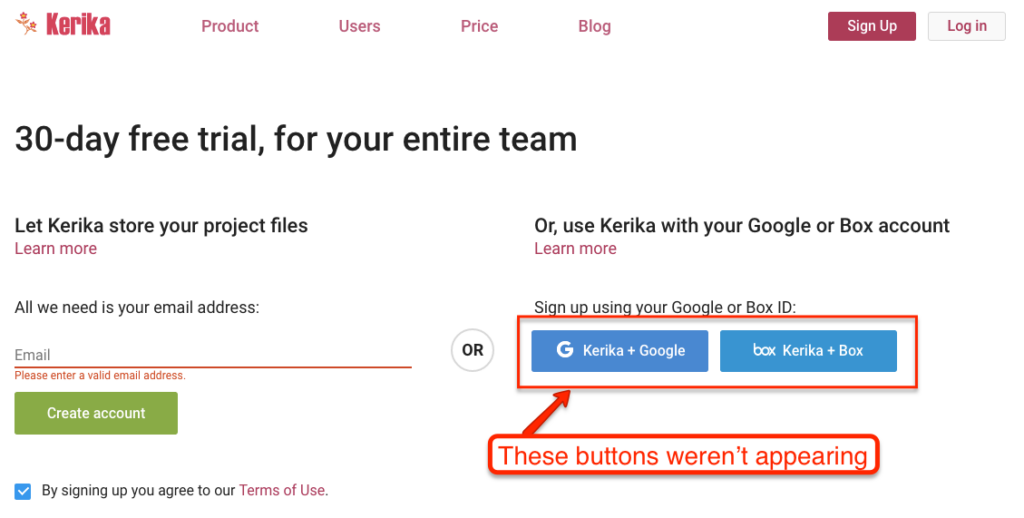
(The same problem showed upon the Login page as well.)
It turns out that the EasyList filter uses JavaScript classes called social-media-header’ and social-media-button, social-button and soc-button which were also the names of classes that Kerika was using.
The conflict caused Kerika’s signup and login buttons for Kerika+Google and Kerika+Box to not appear for Chrome and Firefox users who had AdBlock installed.
It took a while to figure out this was the cause. We are not fans of fanboy.
If you are thinking of using PayPal for invoicing…
Don’t. The system is massively buggy and the company is completely unresponsive to complaints.
The web UI looks like it everything is nice and automated, but in reality you will end up doing a bunch of stuff by hand. Examples of bugs and/or dumb design that have already driven us crazy:
- If you have a bunch of outstanding invoices that you want to cancel, the bulk select/action doesn’t work. No error or anything: it just doesn’t do anything, silently.|
- They use lazy loading to show just a dozen or so invoices at a time, with the rest showing only after you scroll down (like Facebook, Twitter, etc.) If you try to do a search or filter, that works only on the invoices that are currently being displayed, not the full set: presumably resulting from a design decision to make the filter work within the client rather than the server.
- Thanks to a flaky implementation of lazy loading itself, some invoices will appear as duplicates.
It’s pretty clear that Elon Musk has left the building.
Bug, fixed: Export notification wasn’t going away
A small bug fix we did recently: when you do an Export of data from a Task Board or Scrum Board, you get a notification from Kerika when the export completes: that’s because the export could potentially take a long time, if you had a very large board, i.e. with hundreds of cards on it.
(In practice, most exports take just a few seconds, so the notification comes very quickly after you start the Export.)
The notification comes in two forms:
- By email, with a link to open the file containing your exported data.
- In your Kerika Inbox, on the top-right of the Kerika application, looking like this:
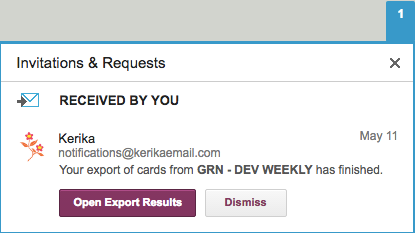
There was a bug that clicking on the “Dismiss” button on Kerika Inbox didn’t make the notification go away: it would reappear after a page refresh.
That bug has been fixed. Enjoy.
Apologies for the long absence…
Sorry for not having posted in a while; we have been swamped with a new UI design that has consumed all of our time.
The new UI, by the way, is all about making Kerika more accessible, particularly to people who are new to visual collaboration.
Our user feedback had revealed a couple of uncomfortable truths that we needed to address:
- Very few users were aware of all the functionality that already exists in Kerika. Which means that we didn’t need to focus so much on building new functions as we did on making sure people understand what Kerika can already do.
- Our new users aren’t just new to Kerika; in most cases, they are new to visual collaboration altogether. Even though there has been a proliferation in recent months of all sorts of companies trying to recast old, tired products as exciting new visual collaboration (hello, Smartsheet!), our new users aren’t converting away from our competitors as much as converting away from paper, email, and SharePoint.
This, then, is the goal of our new UI: to make it easier for people to adapt from paper and email to visual collaboration, and to make it easier for all users to exploit all the great functionality that we have already built.
We will have more on this in the coming months, as we get closer to releasing our new user interface, but in the meantime we have queued up a bunch of blog posts to make sure you know about all the other great stuff we have been working.
Yeah, our biggest problem is we don’t tell people what we have already done…
Automatic version tracking
Another great new feature: if you upload a file on any card, canvas or board with the same name as a file that’s already attached to that particular card, canvas or board, Kerika will automatically keep track of these as being different versions of the same file. This makes it even easier to organize all your Kerika project files.
Here’s how it works:
Kerika lets you add files to any cards, boards or canvases, on any of your Kerika Task Boards, Scrum Boards or Whiteboards.
There’s no limit to the number of files you add, nor any limit on the size of these files.
When you add a file, to a card, board or canvas, Kerika automatically uploads that file and shares that with everyone who is part of your board’s team. You don’t have to do anything: Kerika makes sure that all the Team Members have read+write permission, and all the Visitors have read-only permission.
These files are stored in your Google Drive, if you are using Kerika+Google, or in your Box account, if you are using Kerika+Box, or with Kerika if you have signed up directly with an email address.
That’s how Kerika has always worked; what we have added is an automatic versioning feature that checks when you add a new file to see if has the same name, and type, as a file that’s already attached to that particular card, canvas or board.
If the file name and file type match something that you have already added, Kerika automatically treats that new file as a new version of the old file, rather than as a completely different file. This makes it really easy to manage your Kerika project files.
Here’s an example: this card has a file attached to it called “Foo.docx”.
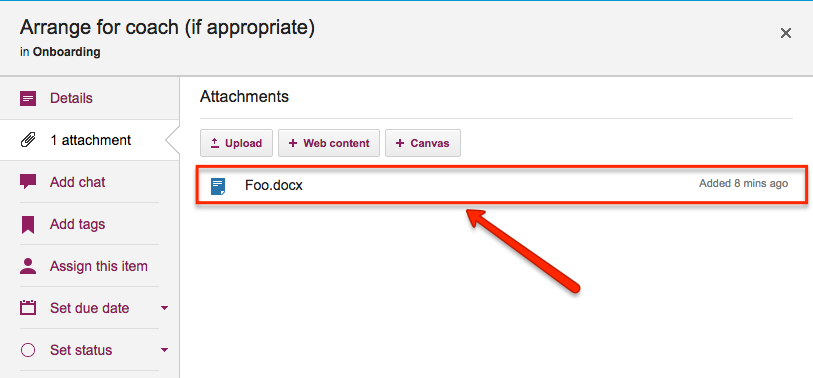
If a Team Member adds another file to this same card, also called “Foo.docx”, Kerika will treat that new file as a different version of the same Foo.docx, rather than as a completely different file:
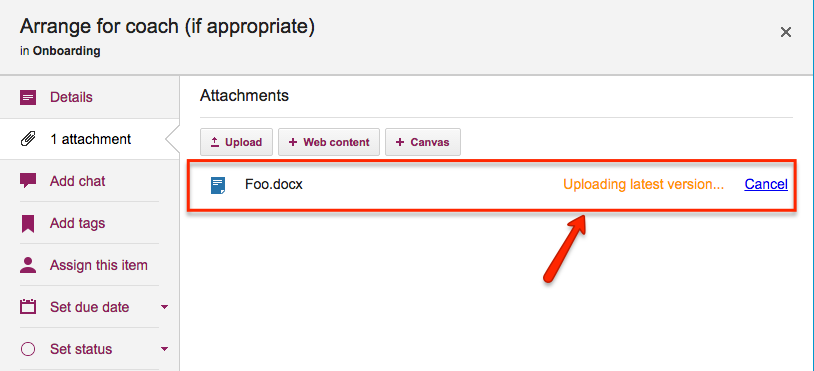
Accessing these older versions is easy: if your Kerika files are in being stored in your Google Drive, you can get the older versions using the Google Docs File menu:
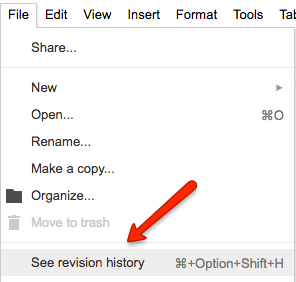
If your files are being stored in your Box account, you can access the older versions from the menu on the right side of Box’s preview window:
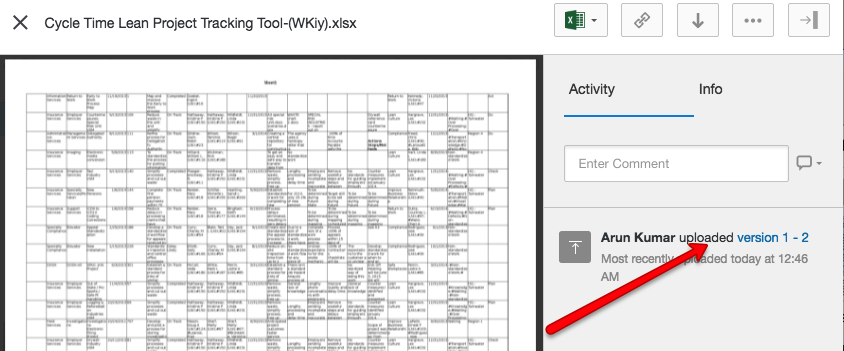
If you signed up directly with Kerika, you can access the older versions from within Kerika’s file preview:

Clicking on the Older versions of this file link on the top right of this preview will give you a list of all the old versions of this file that Kerika has:
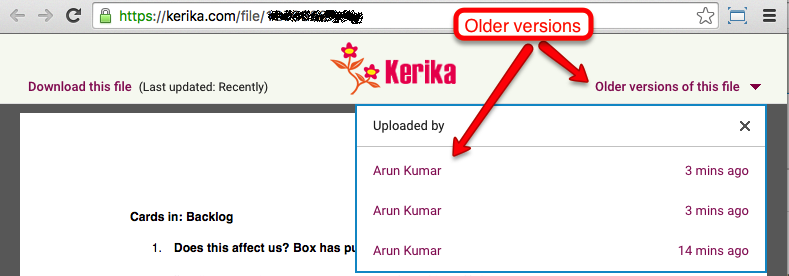
So, that’s it: simple, easy, automatic tracking of multiple versions of your project files! Brought to you by Kerika, of course.
Calendar syncing
We quietly released a new feature a couple of weeks ago that we now want to announce to the world: you can have all your Kerika due dates appear automatically on your Mac, Outlook or Google Calendar!
All you have to do is go to https://kerika.com/preferences (or click on the Preferences link that shows up under your photo in the top-right of the Kerika app), and then click on the Start Syncing button on that page:
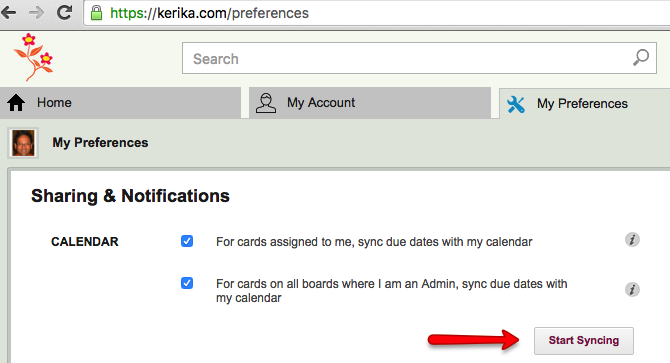
You can sync to your Apple/Mac calendar, your Microsoft Outlook calendar, or your Google Calendar.
Pick your preference, and Kerika will show you detailed instructions on how to start syncing.
Here, for example, are the instructions for syncing to your Apple/Mac calendar:
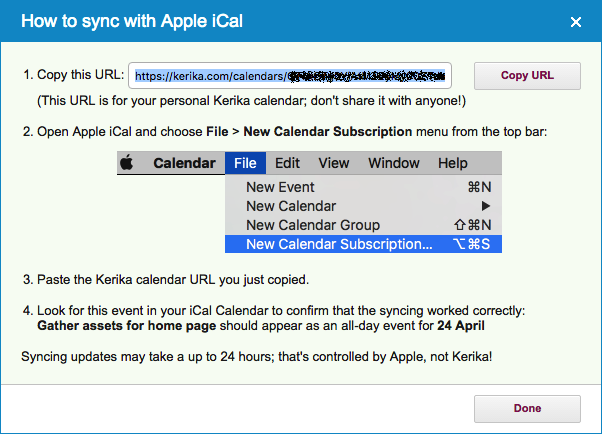
And here are the instructions for syncing to your Microsoft Outlook calendar:
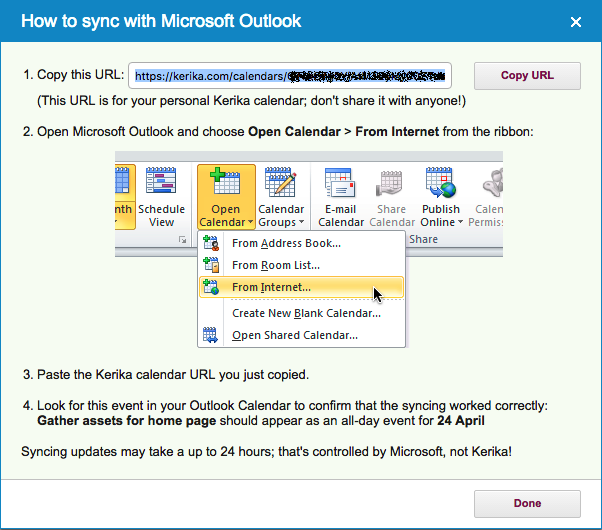
And, finally, here are the instructions for syncing to your Google calendar:
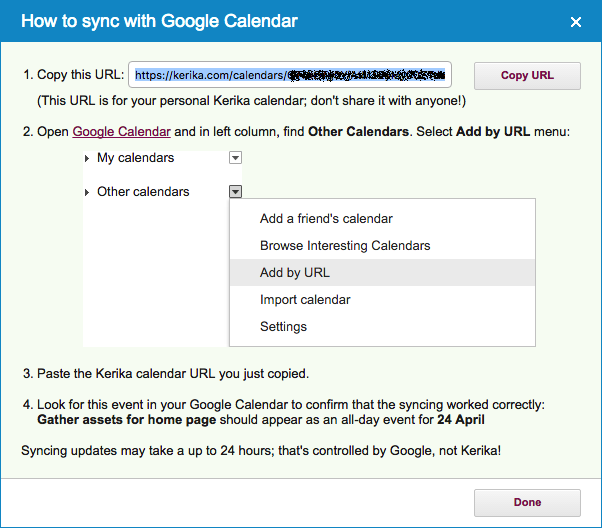
You will notice that we have deliberately obfuscated the actual calendar URL for this particular user, in all three images above.
That’s important: your calendar URL is unique and precious — don’t share it with anyone!
As your cards on your Kerika Task Boards and Scrum Boards get new due dates, Kerika will automatically feed these updates to your personal calendar: you don’t need to do anything.
Kerika due dates always appear as “all day” events.
Please note that it’s up to Apple/Microsoft/Google to determine how quickly these updates show up on your calendar.
On your Mac Calendar, for example, you can set the frequency with which these updates appear by doing a right-click with your mouse on the calendar and selecting Get Info:
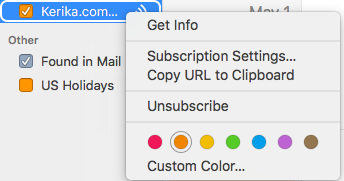
And then setting the “Refresh time” for that particular calendar. (On Macs, the fastest that iCloud allows is every 5 minutes.)
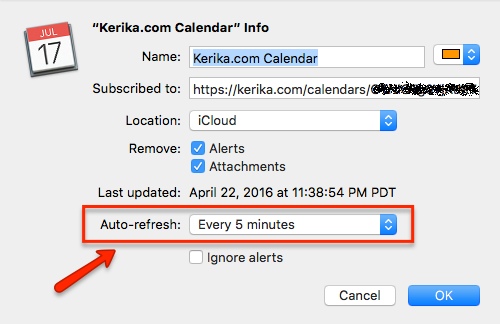
Changing your Kerika password
For folks who sign up directly with Kerika, we store the user password (in an encrypted form, of course), which means that these users can change their passwords directly from within the Kerika application by going to their My Account page at https://kerika.com/my-account:
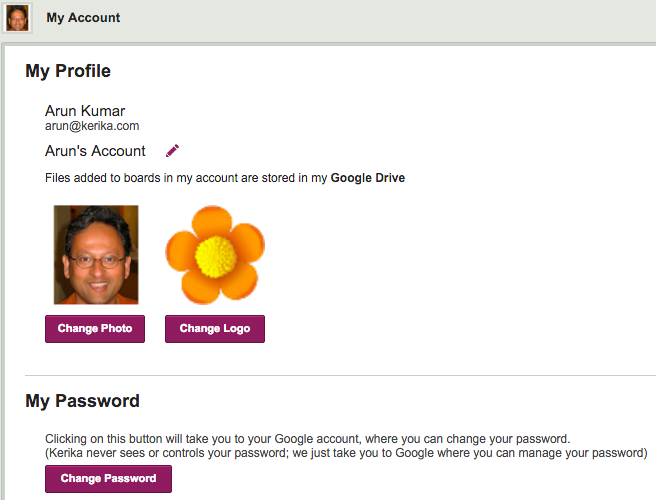
For people who sign up using their Google or Box IDs, we rely upon Google/Box to manage their passwords: in fact, we never even see anyone’s Google or Box password, even for a second!
So, their My Account page looks a little different, like in this example of a Kerika+Google user:
